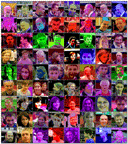:: Monday, November 01, 2004 ::

NEW WRITING: on Proyecto Venus
BY: Ignacio Nieto
Tras la decaída del valor de la moneda argentina hace 10 años se constituyó, ya que no existía circulante, mercados informales que se instalaron por generación espontánea en todas partes de Argentina. los denominados: clubes de trueque que en una oportunidad llegaron hacer unos 10 mil eran lugares donde se podían intercambiar productos que generalmente eran de segunda mano. A raíz de esa experiencia colectiva, un grupo interdisciplinario creó en Noviembre del 2002, una sociedad experimental en red: www.proyectovenus.org compuesta de artistas, intelectuales, tecnólogos, científicos que propone el intercambio, la venta o la compra de servicios.
Para mayor información se puede envía un correo a info@proyectovenus.org
 ORIGINAL POST: Tuesday, October 26, 2004
ORIGINAL POST: Tuesday, October 26, 2004 BY: Garrett Lynch
15 Seconds of Fame is an interactive art installation which I stumbled across in the April of 2004 issue of Leonardo, Vol. 37, Issue 2.
Inspired by Warhol's statement that "In the future everybody will be famous for fifteen minutes," the portrait/installation attempts to do just that: make everybody who observes it famous. It does this by taking photographs of people in front of the work, choosing one face in the image, manipulating it (pop-art style), and finally displaying it on the screen with a unique ID number for them to observe. This continues every fifteen seconds when a new portrait is taken and displayed. Portraits can be ordered via email with the ID number for a period of one month after the exhibition.
While the idea of continuously creating portraits--each with a similar pop style but a unique ID number, all part of one series--and making "everybody...famous" illustrates Warhol's statement are all interesting demonstrations of both the style and ideas of the previous artist, there are other issues in this work that deserve more attention.
The work is a portrait without a predefined subject. It does not capture the likeness of a single sitter, immortalizing their image at one moment of their lives; instead it waits and observes everything that observes it. It is a portrait that is created for observing us turning the convention of a portrait on its head. With a singular and selective eye, it chooses its subjects based on distinguishable features of their faces. The portrait is seeing us, and so, just as we look at it, it looks back at us with our own faces, unlike anything a mirror can do. We become the subject as we stand before it, yet as rapidly as it shows us our portraits, it disposes of them and moves on, emphasizing both the futility of trying to preserve our images and its fleeting machine gaze.
Suggestive of references such as The Portrait of Dorian Gray--where an art work changes to reflect the subjects moral decay to Minority report where the media we observe observes, recognizes, and changes for us--the work created by members of the Faculty of Computer and Information Science University of Ljubljana, Slovenia is indicative of how art and science are combining in ever more complex ways to challenge how we relate to technology as it evolves and becomes possible to realize previous fictions.

ORIGINAL POST: Monday, October 25, 2004
BY: Ana Boa-Ventura
This is a short piece on the first four year-long "Technology and Digital Media" course of its kind in Brazil, at the P.U.C University in S. Paulo. More info in English at the bottom.
EM PORTUGUES:
O vestibular de 4 anos da PUC-SP intitulado " Tecnologia e Novos Midia" acaba de formar seus primeiros graduados. Este curso propoe uma estrutura bem inteligente com 3 direccoes claras (em vez da confusao que frequentemente impera nas instituicoes que oferecem curricula nesta area): "desenho de interface", "educacao 'a distancia" e "arte e tecnologia". Com uma visao inteligente de mercado e de oferta-procura de emprego (ja' que o desenho de interface tem uma componente importante de design de jogos, e a area de educacao a distancia so' pode crescer mesmo...), nao deixa de *existir* um espaco para aqueles que querem trabalhar nessa fronteira complexa e nem sempre lucrativa mas fascinante que e' a fronteira entre arte e tecnologia.
Parabens aos novos graduados!
*********************
IN ENGLISH:
The four-year "vestibular" (Brazilian Portuguese term for college degree) proposes three clear and clever directions (instead of the tangled mess that institutions offering curricula in the new media area often offer): "interface design," "distance learning," and "art & technology." With an eye in the market (since interface design has a strong game design component, and distance learning is a market that can only rise), there is nevertheless a space for those who want to work in that complex but not-always-lucrative twilight zone: the border between art and technology.
Congratulations to the new graduates!